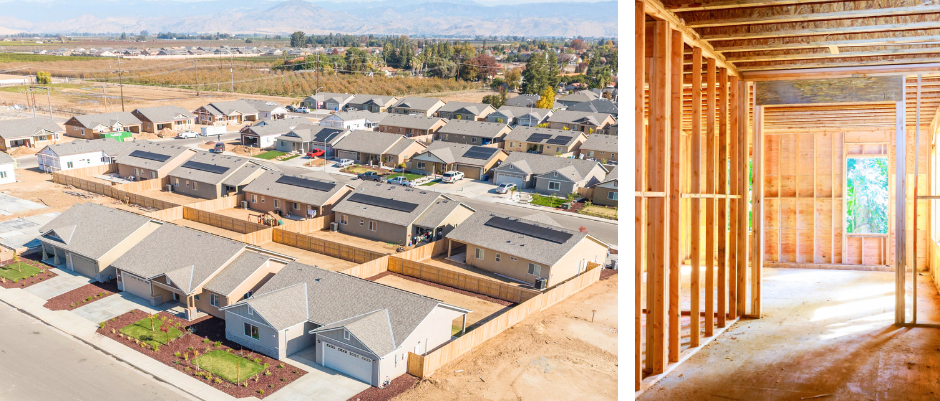Tom’s Take on the National Housing Crisis
Tom’s Take on the National Housing Crisis

Posted on September 4, 2024
 Housing is on everyone’s mind, across the economic and political spectrum. An increasing conversation about the inability of younger people to buy a home, a broken housing market where not enough new homes are being built, Wall Street investments in existing housing stock and its inflationary effect on the market, the highest mortgage and development loan interest rates in decades — has everyone scrambling for ideas how to fix the problem. To highlight how the challenge bridges our famously divided country, housing issues played a prominent role in both the Republican and Democratic conventions this summer.
Housing is on everyone’s mind, across the economic and political spectrum. An increasing conversation about the inability of younger people to buy a home, a broken housing market where not enough new homes are being built, Wall Street investments in existing housing stock and its inflationary effect on the market, the highest mortgage and development loan interest rates in decades — has everyone scrambling for ideas how to fix the problem. To highlight how the challenge bridges our famously divided country, housing issues played a prominent role in both the Republican and Democratic conventions this summer.
So, what is the plan to fix it? Frankly, neither campaign offers enough solutions in their respective platforms. The Harris campaign proposes to put more resources into existing programs, adding a new down payment assistance program (and tax break) for first-time homebuyers. The Trump campaign promises to reduce housing costs by removing regulatory barriers and deporting undocumented immigrants who are occupying too much of our current housing supply. Neither campaign provides many details on how they would accomplish their plans, at least not yet.
In my view, a change in our mindset must come before we can meaningfully respond to the challenge.
When looking at the mismatch of housing to people, the starting point is supply. Simply put, we are not adding enough to our existing housing stock. The Harris campaign has designated the shortage of new housing units nationally at 3 million. In California alone, studies have put the number at 1.2 million, and we continue to fall behind each year. Housing prices and costs are a classic supply and demand story. So how do we build more, faster, and cheaper?
First, we need to treat it as an “everyone” problem. Housing costs strain the budgets of all but the highest-income households, demanding that we halt the upward trajectory of costs of building and renovating housing. This involves a broad range of issues including zoning and permitting, building codes, supply chain challenges, growing our construction labor force, and revising our financing products.

Second, we need to recognize when and where subsidies are needed. For decades, the federal government has spent far more on subsidizing housing for middle- and upper-income households than low-income Americans. Chiefly, this is done through the mortgage interest deductions that homeowners take advantage of at tax time. This is not a bad thing, as it helps to encourage the homebuilding industry and bolsters local governments and economies. But in an environment of constricted federal domestic spending budgets, housing subsidies for our working poor and other low-income families are radically deficient. And we must recognize that we have no subsidies available to middle income renters, part of a huge swath of the “missing middle.” We simply must expand subsidies rather than continue to play a zero-sum game.
Third, we must pursue strategies matching housing needs to housing units. Many elderly homeowners are locked into houses that are more than they need due to favorable mortgage interest rates on older loans and property tax policies such as those in California. This is at a time when younger growing families find it increasingly difficult to purchase or even rent homes that fit their needs. There are also too many affluent and tourist destination communities that routinely restrict the development of higher density housing for their workforce. Housing must be considered a human right in this country instead of a delivery system that relies on localized restrictions, regulations, and resources. Declaring housing a human right would have profound effects on how we address our homelessness challenges, and importantly would have broader implications on housing supply.
Fourth, there needs to be a focal point in the federal government for housing policy to be implemented. You might think that the Department of Housing and Urban Development is that agency, but that is far from true. The US Department of Agriculture, the IRS, and the quasi-independent “Government Sponsored Entities” Fannie Mae and Freddie Mac are all major players in our housing market as well. Even the Department of Health and Human Services is increasingly involved in housing. Unfortunately, none of these agencies are known for playing well together in the housing opportunity sandbox. We’ve had a Drug Czar; why not a Housing Czar?
 Housing development is more complicated than it should be, with a lot of moving parts. But it need not be. In my most hopeful moments, I dream that something good may come from this crisis of widespread unaffordable housing; that at least now people will understand the problem of affordability and the need for subsidy and meaningful cost reduction for housing development writ large. For any challenge, before substantive change can become reality, more people need to be directly impacted. That time is now…. even if the two presidential candidates do not realize it yet.
Housing development is more complicated than it should be, with a lot of moving parts. But it need not be. In my most hopeful moments, I dream that something good may come from this crisis of widespread unaffordable housing; that at least now people will understand the problem of affordability and the need for subsidy and meaningful cost reduction for housing development writ large. For any challenge, before substantive change can become reality, more people need to be directly impacted. That time is now…. even if the two presidential candidates do not realize it yet.
Recent Posts
- BCLT Groundbreaking Marks New Affordable Homes in Bakersfield!
- Celebrating NeighborWorks Week and 300th Home Milestone in Planada!
- Groundbreaking Marks New Chapter for Tombstone Water System
- Southwest Fresno Families Celebrate Their Self-Built Homes
- Celebrating the Grand Opening of River Grove in Oakhurst!
Recent Comments
Archives
- August 2025
- June 2025
- May 2025
- April 2025
- February 2025
- January 2025
- December 2024
- November 2024
- October 2024
- September 2024
- August 2024
- July 2024
- June 2024
- April 2024
- February 2024
- January 2024
- December 2023
- October 2023
- September 2023
- August 2023
- July 2023
- June 2023
- May 2023
- April 2023
- March 2023
- February 2023
- December 2022
- October 2022
- September 2022
- August 2022
- July 2022
- May 2022
- December 2021
- October 2021
- September 2021
- August 2021
- July 2021
- June 2021
- May 2021
- April 2021
- March 2021
- January 2021
- December 2020
- November 2020
- October 2020
- September 2020
- July 2020
- June 2020
- May 2020
- April 2020
- March 2020
- February 2020
- January 2020
- December 2019
- November 2019
- October 2019
- September 2019
- August 2019
- July 2019
- June 2019
- May 2019
- April 2019
- March 2019
- February 2019
- January 2019
- December 2018
- November 2018
- October 2018
- September 2018
- August 2018
- July 2018
- June 2018
- May 2018
- April 2018
- March 2018
- February 2018
- January 2018
- December 2017
- November 2017
- October 2017
- September 2017
- August 2017
- July 2017
- June 2017
- May 2017
- April 2017
- March 2017
- February 2017
- January 2017
- December 2016
- November 2016
- October 2016
- September 2016
- August 2016
- July 2016
- June 2016
- May 2016
- April 2016
- March 2016
- February 2016
- December 2015
- November 2015
- October 2015
- September 2015
- August 2015
- July 2015
- June 2015
- May 2015
- April 2015
- February 2015
